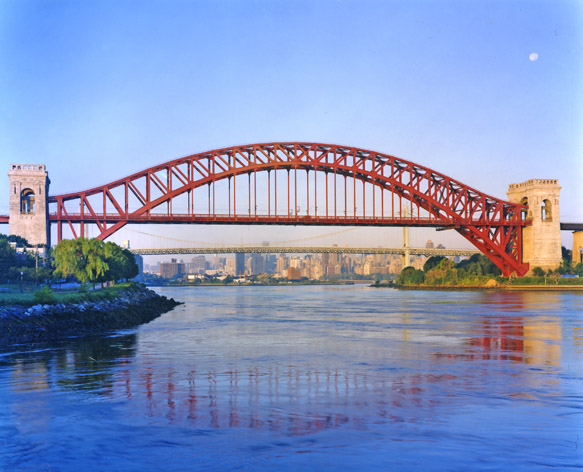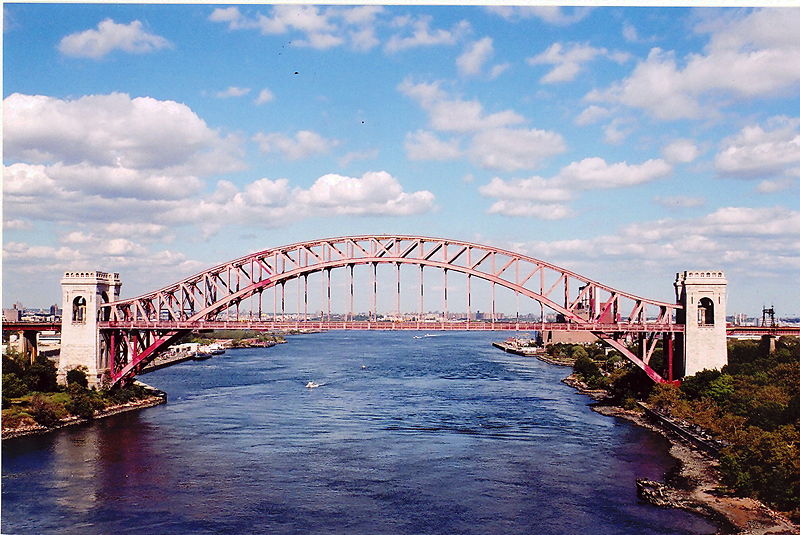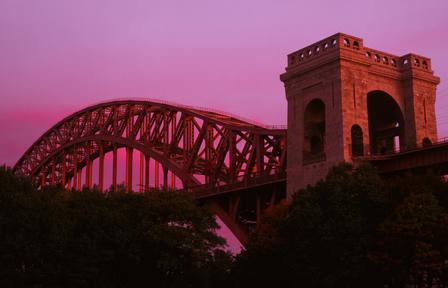Hell Gate Bridge
The Hell Gate Bridge (originally the New York Connecting Railroad Bridge or The East River Arch Bridge) is a 1,017-foot (310 m) steel arch railroad bridge between Astoria in the borough of Queens and Randall's and Ward's Islands (which are now joined into one island and are politically part of Manhattan) in New York City, over a portion of the East River known as Hell Gate.

Hell Gate Bridge
Carries Amtrak Northeast Corridor rail line (2 tracks);
CSX/Canadian Pacific freight rail line (1 track)
Crosses Hell Gate of the East River
Locale Queens and the Bronx in New York City via Randall's and Ward's Islands
Design Arch bridge
Longest span 1017 feet (310 m)
Total length 17,000 feet
Width 100 feet (30.5 m)
Clearance below 135 feet (41 m)
Opening date September 30, 1916

The bridge is used by Amtrak and by some CSX, Canadian Pacific, Providence & Worcester Railroad, and New York and Atlantic freight trains. The bridge and structure are owned by Amtrak, part of its Washington, D.C. to Boston electrified main line known as the Northeast Corridor. Metro-North Railroad trains may one day run on the bridge. The bridge is also part of the New York Connecting Railroad, a rail line that links New York City and Long Island to the North American mainland. The Hell Gate Bridge runs parallel to the Queens span of the Triborough Bridge, which connects Queens, the Bronx, and Manhattan, and drivers can see the length of the bridge just east of the roadway.

The great arch bridge is the largest of three bridges, along with more than 17,000 feet (5.2 km) long of approach spans and viaducts, that form the Hell Gate complex. An inverted bowstring truss bridge with four 300-foot spans crosses the Little Hell Gate (now filled in); and a 350-foot fixed truss bridge crosses the Bronx Kill (now narrowed by fill). This bridge was the inspiration for the Sydney Harbour Bridge in Sydney, Australia. The bridge was conceived in the early 1900s as a way to link New York and the Pennsylvania Railroad with New England and the New Haven Railroad. Construction was overseen by Gustav Lindenthal, whose original design left a gap of 15 feet between the steel arch and the masonry towers. Fearing that the public assumed that the towers were structurally integral to the bridge, Lindenthal added aesthetic girders between the upper chord of the arch and the towers to make the structure appear more robust. The original plans for the piers on the long approach ramps called for a steel lattice structure. The design was changed to smooth concrete to soothe concerns that asylum inmates on Ward's and Randall's islands would climb the piers to escape. The engineering was so precise that when the last section of the main span was lifted into place, the final adjustment needed to join everything together was half an inch. The bridge was completed on September 30, 1916. It was the world's longest steel arch bridge until the Bayonne Bridge was opened in 1931, and was surpassed again by the Sydney Harbour Bridge in 1932. The bridge originally carried four tracks, two each for passenger and freight, but one freight track was abandoned in the mid-1970s. At one time, all tracks were electrified with the NH-PRR standard 11 kV 25 Hz overhead catenary; the passenger tracks since 1917, and the freight tracks from 1927 to 1969. In 1996, the bridge received a facelift, including its first comprehensive paint job in 80 years. It was painted "Hell Gate Red," a dark, natural red.